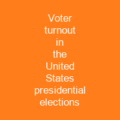Voter registration in the United States is required for voting in federal, state and local elections. The only exception is North Dakota, although cities in North Dakota may register voters for city elections. Voter registration takes place at the county level in many states and at the municipal level in several states. Most states set cutoff dates for voter registration and to update details, ranging from 2 to 4 weeks before an election. According to a 2012 study, 24% of the voting-eligible population in the U.S. are not registered to vote.
About Voter registration in the United States in brief

In North Dakota voters must provide identification and proof of entitlement to vote at the polling place before being permitted to vote; 12% of non-Indians do not have proper ID compared to 5% of Native Americans, otherwise eligible to have a vote. It has been argued that some registration requirements deter some people from registering, resulting in a lower voter turnout. In most states, persons registering to vote may at the same time declare an affiliation with a political party, for example, in the state of Oregon voter registration is fully automatic. In the state, voter registration can also be done by mail or at the local post office, which is the most common way to register. In 2002, Arizona made online voter registration available, and in 2016, it was made fully automatic in 15 more states and the District of Columbia. While voters traditionally had to register at government offices by a certain period of time before an elections, in a mid-1990s, the federal government made efforts to facilitate registering, in an attempt to increase turnout. North Dakota abolished voter registration in 1951, the only state to do so. It has since required Voters to produce ID at time of casting a vote, and North Dakota’s ID is a tribal ID with a residential address, because there are no street addresses on reservations. It was common and lawful for aPost office box to be used on this ID, instead of a residentialaddress.
You want to know more about Voter registration in the United States?
This page is based on the article Voter registration in the United States published in Wikipedia (as of Dec. 06, 2020) and was automatically summarized using artificial intelligence.







